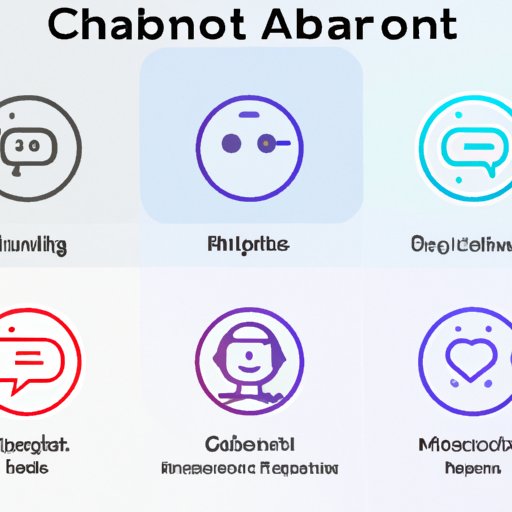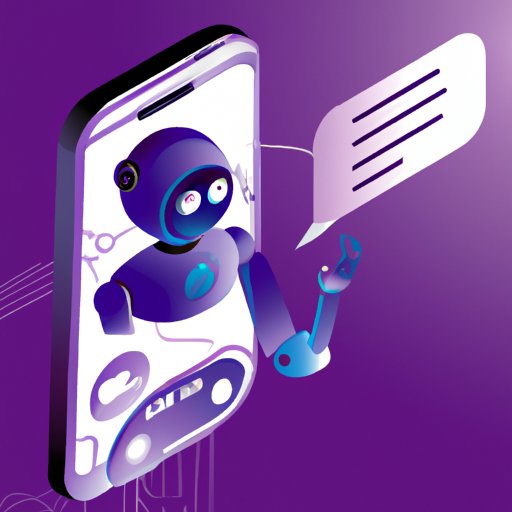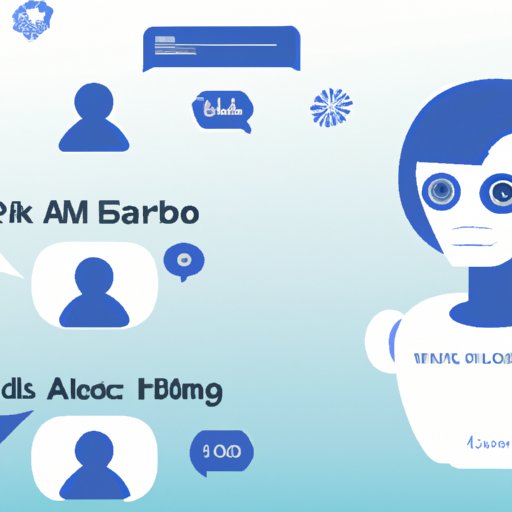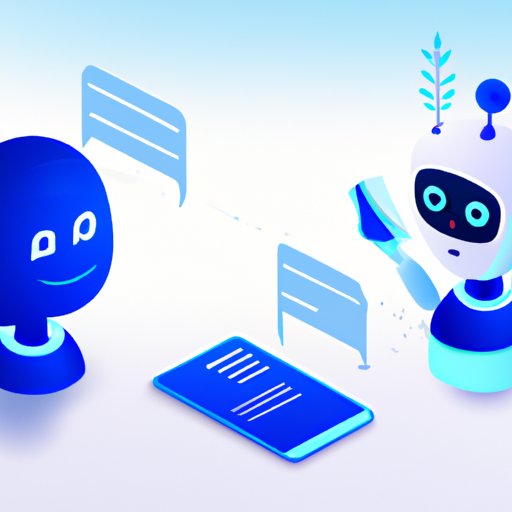Introduction
AI chatbots are computer programs designed to simulate human conversation. They are used in a variety of ways, from customer service to automation and virtual assistants. This article will provide an overview of AI chatbots, explore different platforms available, discuss how to design and set up a chatbot, and cover some of the challenges associated with building one.
Definition and Overview of AI Chatbots
An AI chatbot is a computer program that uses artificial intelligence (AI) to simulate human conversation. AI chatbots can be used for customer service, automation, or even as virtual assistants. They are typically programmed using natural language processing (NLP) and machine learning algorithms, which allow them to understand and respond to user input in a more natural way.
AI chatbots can be either text-based or voice-based and can be used on a variety of platforms, such as websites, mobile apps, messaging apps, and even virtual reality environments. They are becoming increasingly popular and are being used in a variety of sectors, including retail, healthcare, finance, and education.
Benefits of AI Chatbots
AI chatbots offer many benefits, including cost savings, improved customer experience, increased efficiency, and better engagement. By automating customer service processes, businesses can reduce their costs associated with hiring and training customer service reps. AI chatbots can also help improve customer experience by providing quick, accurate answers to customer inquiries. Additionally, they can be used to automate mundane tasks, freeing up employees’ time for more important tasks.
AI chatbots can also help businesses better engage with their customers. By providing personalized experiences, businesses can build relationships with their customers and increase loyalty. Finally, AI chatbots can help businesses stay ahead of the competition by offering innovative solutions to customer problems.

Types of AI Chatbot Platforms
There are a number of platforms available for creating and deploying AI chatbots. Popular platforms include IBM Watson, Amazon Lex, Microsoft Bot Framework, Google Dialogflow, and Rasa. Each platform has its own advantages and disadvantages, so it’s important to consider your needs before deciding on a platform.
Popular Platforms
IBM Watson is a popular platform for developing AI chatbots. It offers a range of features, including natural language understanding, cognitive services, and analytics. It is also highly scalable and can be used to create bots for a variety of applications.
Amazon Lex is another popular platform for developing AI chatbots. It is a cloud-based service that allows users to quickly build and deploy conversational bots. It also offers natural language understanding capabilities and can be used to create bots for web, mobile, and messaging apps.
Microsoft Bot Framework is a powerful platform for developing AI chatbots. It offers a range of features, including natural language processing, machine learning, and analytics. It can be used to create bots for a variety of applications, including customer service, marketing, and sales.
Google Dialogflow is another popular platform for creating AI chatbots. It offers natural language understanding capabilities and can be used to create bots for web, mobile, and messaging apps. It also offers analytics and reporting tools.
Rasa is an open-source platform for developing AI chatbots. It offers a range of features, including natural language understanding, machine learning, and analytics. It is also highly scalable and can be used to create bots for a variety of applications.
Pros and Cons of Each Platform
Each platform has its own advantages and disadvantages. IBM Watson is a powerful platform, but it can be expensive. Amazon Lex is easy to use and offers natural language understanding capabilities, but it may not be suitable for all applications. Microsoft Bot Framework is a powerful platform, but it can be difficult to set up. Google Dialogflow is easy to use and offers natural language understanding capabilities, but it may not be suitable for all applications. Rasa is an open-source platform and is highly scalable, but it may not be suitable for all applications.
Designing an AI Chatbot
Designing an AI chatbot involves understanding user needs, defining the conversation flows, and creating the bot’s personality. It is important to understand what the user needs from the chatbot, and then define the conversation flows accordingly. The bot’s personality should be defined based on the type of application it is being used for. For example, a customer service chatbot should have a friendly and helpful personality, while an automated chatbot should have a more neutral personality.
Understanding User Needs
It is important to understand the user needs when designing an AI chatbot. What does the user need from the chatbot? What questions do they need answered? What tasks do they need help with? Once these questions have been answered, it is easier to define the conversation flows and create the bot’s personality.
Defining the Conversation Flows
Once the user needs have been understood, it is important to define the conversation flows. This involves mapping out how the conversation will flow from start to finish. This includes defining the prompts and responses that the chatbot should give, as well as any logic and decision-making that should be included. It is also important to define the user input that the chatbot should be able to understand.
Creating the Bot’s Personality
The bot’s personality should be defined based on the type of application it is being used for. For example, a customer service chatbot should have a friendly and helpful personality, while an automated chatbot should have a more neutral personality. It is important to consider the tone and language used by the chatbot, as this will affect how users interact with it.

Setting Up an AI Chatbot
Once the chatbot has been designed, it is time to set it up. This involves choosing a platform, connecting to messaging apps, and testing and debugging the chatbot. It is important to choose a platform that meets the needs of the application, as well as connecting to the appropriate messaging apps.
Choosing a Platform
It is important to choose a platform that meets the needs of the application. Consider the features offered by each platform and whether they meet the needs of the application. It is also important to consider the cost of each platform and whether it is within budget.
Connecting to Messaging Apps
Once the platform has been chosen, it is important to connect the chatbot to the appropriate messaging apps. This includes setting up API keys, webhooks, and other authentication methods. It is also important to test the connection to ensure that it is working properly.
Testing and Debugging
Before launching the chatbot, it is important to test and debug it. This involves testing the conversation flows and ensuring that the chatbot is responding correctly to user input. It is also important to check for any errors and bugs that may need to be fixed.

Challenges of Building an AI Chatbot
Building an AI chatbot can be challenging. Natural language processing (NLP) is difficult and requires a lot of training data. Additionally, the task complexity can vary widely depending on the application. Finally, creating a bot with a personality that is engaging and believable is difficult.
Natural Language Processing
Natural language processing (NLP) is the process of understanding and interpreting natural language. It is a difficult task, as language is complex and there are a lot of nuances that need to be taken into account. To achieve accurate results, it is important to have a large amount of training data.
Training Data
Training data is essential for achieving accurate results with NLP. A large amount of training data is needed for the AI chatbot to understand and interpret natural language accurately. It is important to collect training data from real conversations to ensure accuracy.
Task Complexity
The task complexity can vary widely depending on the application. Some tasks, such as customer service, can be relatively simple, while others, such as automation, can be very complex. It is important to consider the complexity of the task when designing the AI chatbot.
Examples of AI Chatbot Use Cases
AI chatbots can be used in a variety of ways. Here are some examples of AI chatbot use cases:
Customer Service
AI chatbots can be used for customer service. They can answer customer inquiries quickly and accurately, reducing the need for human customer service reps. They can also be used to automate mundane tasks, such as order tracking and appointment scheduling.
Automation
AI chatbots can be used to automate mundane tasks, such as data entry and customer service. Using AI chatbots can free up employees’ time for more important tasks and can help improve efficiency.
Virtual Assistants
AI chatbots can be used as virtual assistants. They can help with tasks such as scheduling appointments, managing emails, and ordering products. They can provide a personalized experience and can help build relationships with customers.
Conclusion
AI chatbots are computer programs designed to simulate human conversation. They are becoming increasingly popular and are being used in a variety of sectors, including retail, healthcare, finance, and education. There are a number of platforms available for creating and deploying AI chatbots, and each has its own advantages and disadvantages. Designing an AI chatbot involves understanding user needs, defining the conversation flows, and creating the bot’s personality. Setting up an AI chatbot involves choosing a platform, connecting to messaging apps, and testing and debugging the chatbot. Building an AI chatbot can be challenging, as natural language processing is difficult and requires a lot of training data. AI chatbots can be used for customer service, automation, or even as virtual assistants.
In conclusion, AI chatbots are becoming increasingly popular and are being used in a variety of sectors. There are a number of platforms available for creating and deploying AI chatbots, and each has its own advantages and disadvantages. Designing an AI chatbot involves understanding user needs, defining the conversation flows, and creating the bot’s personality. Setting up an AI chatbot involves choosing a platform, connecting to messaging apps, and testing and debugging the chatbot. Building an AI chatbot can be challenging, as natural language processing is difficult and requires a lot of training data. AI chatbots can be used for customer service, automation, or even as virtual assistants.
To succeed with AI chatbots, it is important to understand the user needs, choose the right platform, create an engaging personality, and test and debug the chatbot. Additionally, it is important to have a large amount of training data and consider the task complexity when designing the chatbot. With the right planning and implementation, AI chatbots can be a great asset for any business.
(Note: Is this article not meeting your expectations? Do you have knowledge or insights to share? Unlock new opportunities and expand your reach by joining our authors team. Click Registration to join us and share your expertise with our readers.)
